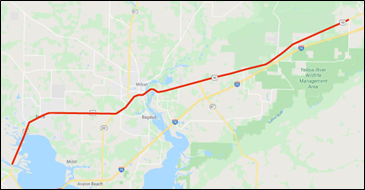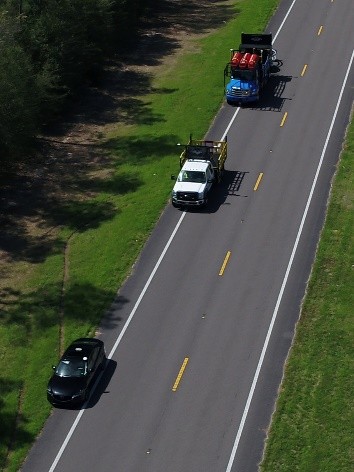CAV Projects (ATMA)
The Florida Department of Transportation (FDOT) District 3 recently completed collection of global positioning system (GPS) seed file data along 28 miles of US-90 in Santa Rosa County for the purpose of accurately mapping proposed intelligent transportation systems (ITS) infrastructure into the ITS Facility Management (ITSFM) system. What made this data collection effort unique was the first-time-ever use in Florida of an autonomous truck-mounted attenuator (ATMA) vehicle to collect the data in support of the upcoming ITS fiber deployment from I-10 to Milton Operations along Avalon Boulevard and US-90.
First developed by the United States military, an ATMA vehicle is a self-driving truck that operates completely unmanned as a follower vehicle when it is paired with a lead vehicle. The ATMA vehicle follows the lead vehicle, matching the lead vehicle movements using steering, throttle, and brake actuators. The ATMA vehicle uses a front-mounted radar to detect the lead vehicle. Using an ATMA vehicle allows for a safer scenario in the unlikely event of a crash.
The ATMA vehicle is equipped with both radar and LIDAR sensors to safely avoid hitting objects such as other cars or pedestrians. However, one object that was not anticipated was tall grass. During one of our attempts to pull over and let motorists pass, the ATMA vehicle “unlinked” from the lead vehicle after it had pulled completely off the roadway. The team had not anticipated that tall grass might be an obstacle. When the ATMA vehicle attempted to pull over, it sensed the tall grass and interpreted it as an object. Therefore, the emergency breaking system was engaged and the ATMA vehicle came to a stop. This was not anticipated but was the correct response by the ATMA vehicle as it encounters a perceived hazard or obstacle.
For insurance purposes, the vendor required a “driver” to be present at all times for the ATMA vehicle. For safety reasons, the vendor’s insurance policy did not allow them to drive autonomously on active roadways without the presence of a driver. Milton Operations has a long driveway behind their facilities that the team used to perform a demonstration of full autonomy, while the “driver” either walked beside the ATMA vehicle or rode in the cab on the lead vehicle. As connected-autonomous vehicle applications advance, we hope to see these types of restrictions reduced since one of the most compelling reasons for ATMA vehicles is to reduce the risk to drivers and occupants of injury in the event the ATMA vehicle is struck by an impaired or distracted driver.
FDOT District 3 considers that implementation of this project was a huge success. When the project was completed for the day, all objectives were met, including:
- Performance of all activities in a safe manner
- Collection of GPS seed file data for ITSFM system use
- Operation of the ATMA without a driver (either “hands-off” in the driver seat, or with no driver at all)
- Preservation of a relatively “fixed” separation between the lead vehicle and the ATMA vehicle
- Demonstration of pulling over and allowing motorists to pass the ATMA moving operation




For additional information, please contact Amy DiRusso at Amy.Dirusso@dot.state.fl.us

